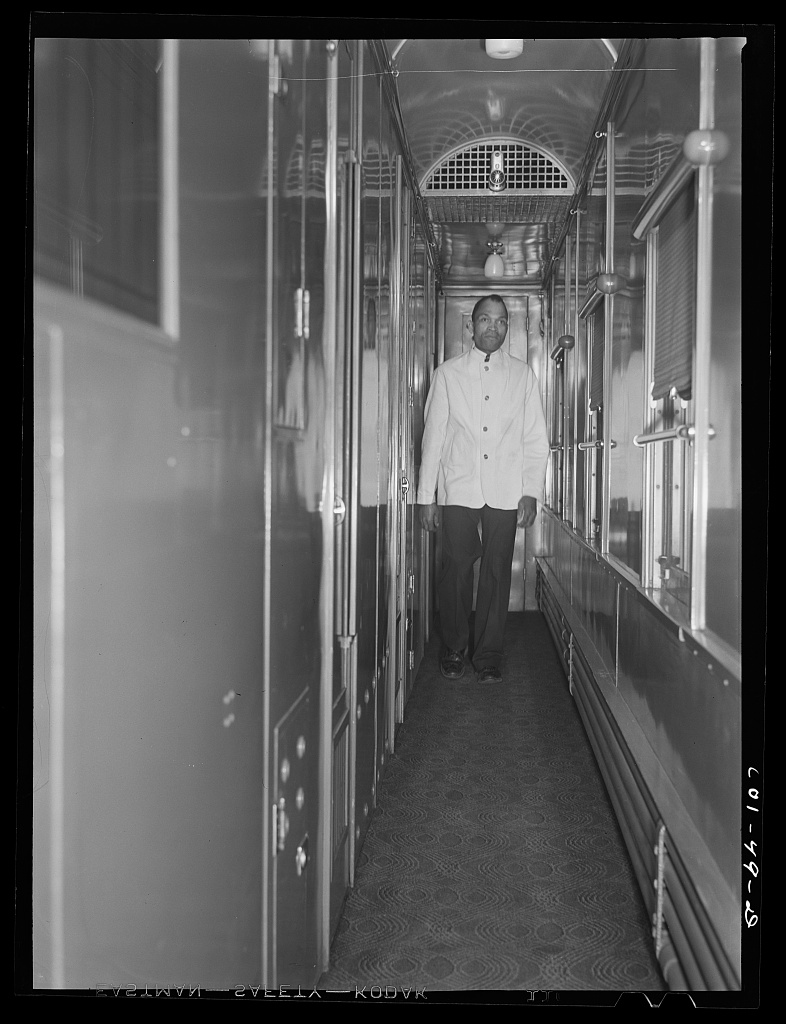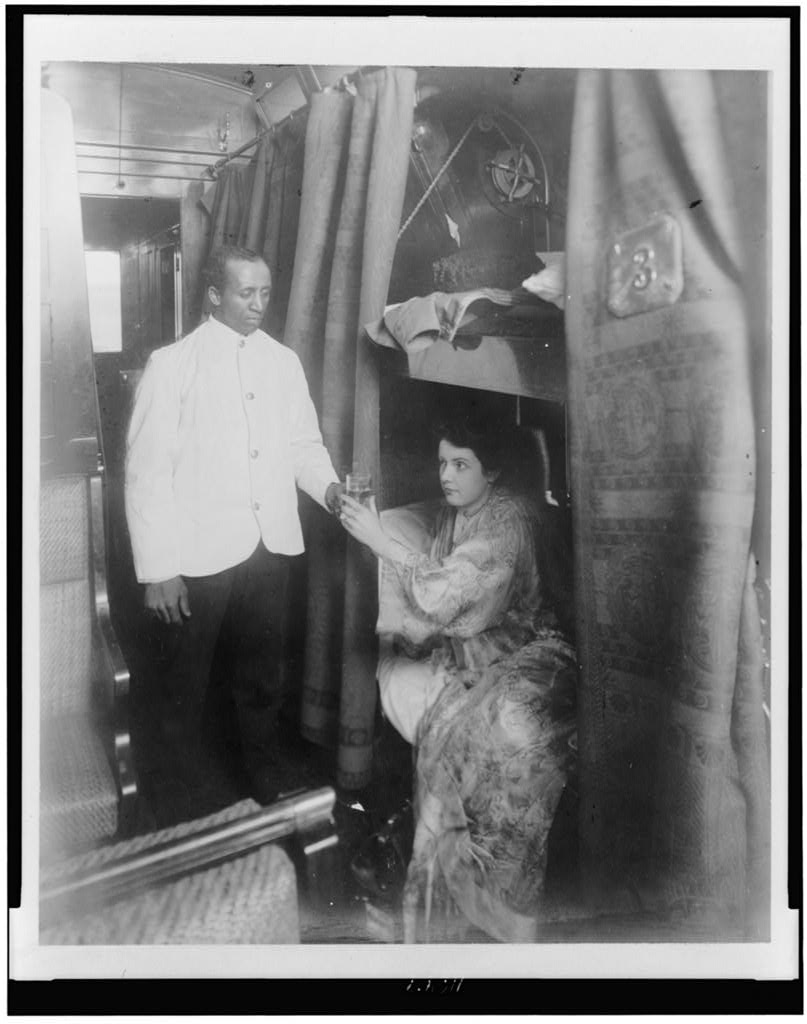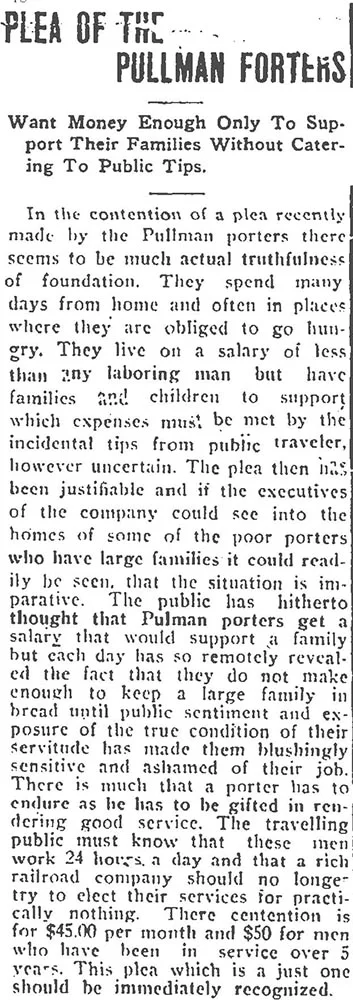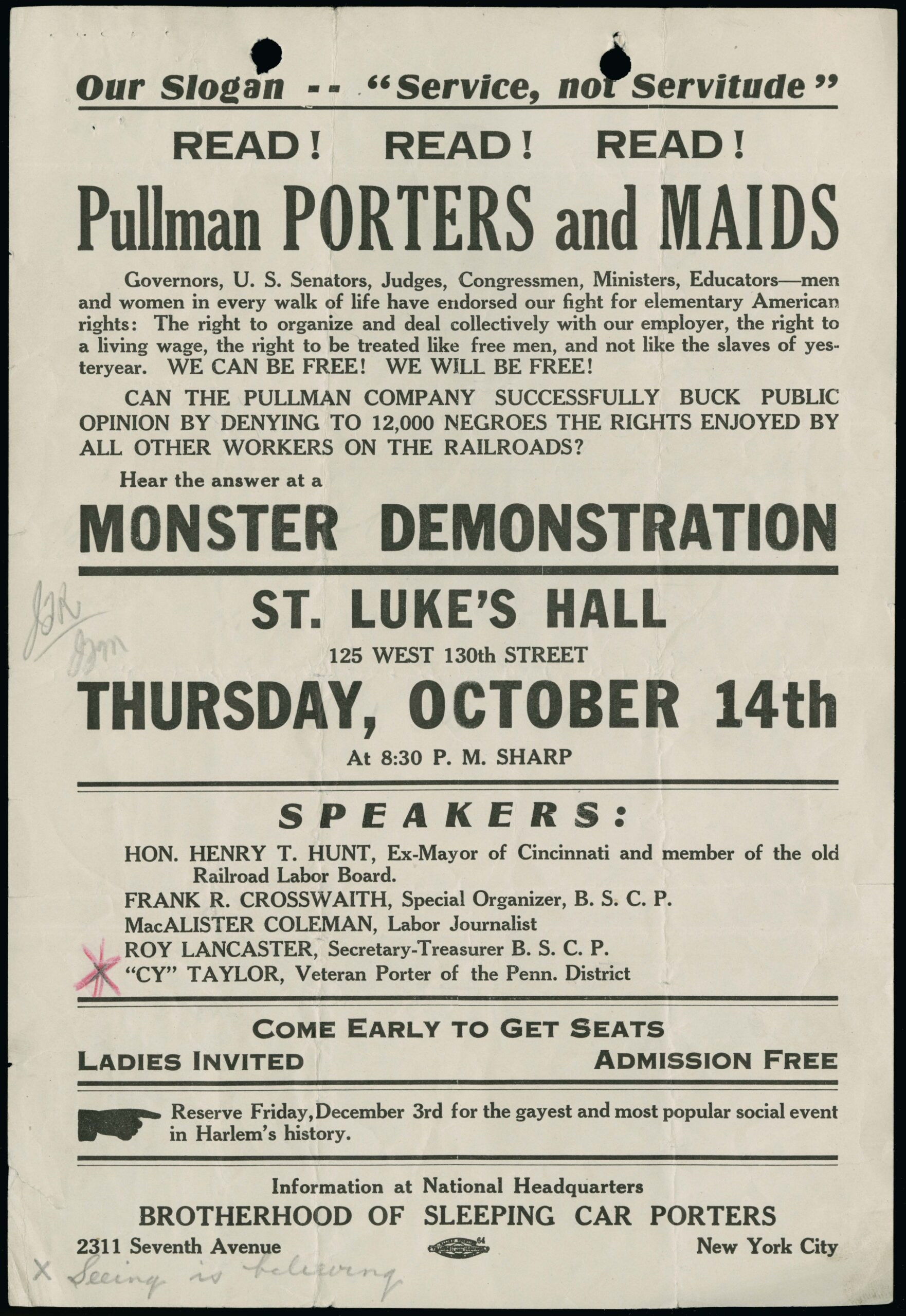Unit
Years: 1920-1942

Economy & Society

Historical Events, Movements, and Figures
Prior to this lesson, students should be familiar with the history of post-Civil War African American history, in particular the Great Migration, exploitative working conditions, and the “Separate but Equal” ideology enshrined in Plessy v Ferguson.
You may want to consider prior to teaching this lesson: Moving North Plessy v. Ferguson Sustaining a Living
The Brotherhood of Sleeping Car Porters was the first successful Black trade union in the United States, whose motto was “Fight or Be Slaves.” A. Philip Randolph founded the union and was elected its first president in 1925. The Brotherhood laid the foundations for an empowered Black middle class by spreading information across the country, providing a successful model of Black union membership, and successfully bargaining for increased respect, rights and wages across gender lines.
In 1867, New York cabinetmaker George Pullman formed The Pullman Sleeping Car Company outside of Chicago in order to offer a railway experience that featured luxury sleeping and dining cars. Pullman, who was White, exclusively hired Black staff to be the porters, maids and laundresses on these sleeping cars. He particularly sought dark-skinned people who were formerly enslaved, reasoning that he could pay these workers less, require them to work longer hours, and capitalize on the expectation of race-based servitude established by the American slave system. In fact, Pullman Porters only received their full salary of $60 a month if they succeeded in working 400 hours or 11,000 miles in that month. Individual porters were expected to do everything an entire hotel staff would do, including shining shoes, greeting passengers, carrying luggage, delivering food, cleaning, minding children, and helping customers with whatever else they might need. They were allowed a maximum of 4 hours of sleep on a couch that was kept behind a curtain in a smoking lounge. They often worked twenty-four-hour stretches or more at a time.
Despite this, becoming a Pullman Porter was one of the best jobs available to Black men in the early 20th century US. By the 1920s the Pullman Company, with 12,000 Black workers, was the largest employer of African American men in the country. For this reason, many leaders in the Black community praised George Pullman, despite the exploitative treatment of the porters and maids. When these Black workers wanted to join national labor unions, like the American Federation of Labor, the White unions refused to recognize Black workers as members. Pullman, hearing of workers’ discontent, formed a “Company Union” led by his own personal Black attendant that fought for very small changes. Whenever a porter or maid pushed for major changes, members of the Company Union would report them and they would be fired. Therefore, a small group of porters asked civil rights leader and labor activist A. Philip Randolph to start the Brotherhood of Sleeping Car Porters. They reasoned that since Randolph was not a porter himself, Pullman could not get retribution by firing him. He founded and became first president of the union in 1925, and the union took the motto “Fight or Be Slaves.”
Over a period of twelve years, the Black Pullman maids and porters fought discrimination, political lobbying, physical attacks, and the possibility of being fired to form their own labor union – The Brotherhood of Sleeping Car Porters (and Maids). Randolph even traveled into Canada to make the organization international. One of the strongest opponents of the BSCP was Robert Todd Lincoln, Abraham Lincoln’s son, who became president of the Pullman Company when George Pullman died. Robert Lincoln was such a ferocious opponent of the union that Pullman Porters sometimes said, “Lincoln freed the slaves and his son re-enslaved them.”
The inclusion of maids in the title of the union fluctuated over the course of the century, but the role of the maids (as well as the spouses of porters) did not. Women were very active in the “Brotherhood,” often forming Auxiliary groups responsible for the actual organization, reach, recruitment, funding, and success of the union.
Despite major challenges, on August 25, 1937, the Pullman Company (and the AFL) finally recognized the BSCP and signed a labor agreement with this union of Black porters and maids. It was the first time an all-Black union had negotiated a contract with a major U.S. corporation. Among other victories, porters received their largest single pay raise up to that time. Minimum salaries went from $77.50 a month to $89.50 and the maximum pay went from $88.50 to $100.50, while required hours decreased from 400 hours a month to 220 hours a month. There were other wins as well. For example, name plates were installed in each train cabin so that passengers would stop calling porters racial slurs or “George” (after the entrenched American Slave Society custom of calling an enslaved person by the first name of their enslaver – i.e. George Pullman), and they could instead be called by their correct names – a small but meaningful sign of respect.
The tenacity, prestige and fraternity of the Pullman Maids and Porters had an enormous impact, not just on employees of Pullman but on Black workers everywhere. Many Pullman Porters became influential members of the Civil Rights Movement, organizing and funding some of the groups and actions we think of most prominently today. Pullman workers also had the opportunity to see the nation as they “rode the rails.” They delivered news across the country and they learned enough about the ways of White America to make prudent investments both financially and educationally. Children of Pullman Porters created an empowered Black middle class that included Thurgood Marshall, and their descendants include prominent Black Americans like Malcolm X, Whoopi Goldberg, and Michelle Obama.
The Brotherhood of Sleeping Car Porters was the first successful Black trade union in the United States. In 1978, the Brotherhood of Sleeping Car Porters merged with the Brotherhood of Railway and Airline Clerks. A. Philip Randolph continued his work for labor and racial justice until his death in 1979 at the age of ninety.
Book: Rising from the Rails: Pullman Porters and the Making of the Black Middle Class by Larry Tye (2005)
Book: Marching Together: Women of the Brotherhood of Sleeping Car Porters (Working Class in American History) by Melinda Chateauvert (1997)
Podcast: Pullman Porters, Creating A Black Middle Class – May 8, 2009 Fresh Air (19 min)
Podcast: The Brotherhood of Sleeping Car Porters (31 min) – Stuff You Missed in History Class, February 26, 2014
Video: Randolph, Rustin, & the Origins of the March on Washington: Crash Course Black American History #32 (12:49) Jan 28, 2022 Black American History
Video: Teaching Black History & Culture: The Pullman Porters NKU Scripps Howard Center for Civic Engagement (6:07) Jan 17, 2021
Video: “Rise from the Rails: The Story of the Pullman Porter” –DemocracyNow! (2009)
Film: Miles of Smiles: Years of Struggle (58 min) California Newsreel 1989 (Trailer)
Film: 10,000 Black Men Named George (95 min) Showtime (2002)
The Brotherhood of Sleeping Car Porters (and Maids) offers an excellent opportunity to examine the complexities of race, class and gender. In some ways, the position of Pullman Porter was extremely prestigious. Scholar Larry Tye lists it as one of the two top jobs open to Black men in the early 20th century. Yet, the positions were frequently demeaning and fundamentally exploitative. It is important to select activities for students that allow them to interact with primary sources that explain the exploitation alongside the merits of a porter position being a “good job.”
Colorism and institutional racism were the leading factors in George Pullman’s hiring decisions. Colorism is the systemic and ideological skin color privilege granted to light-skinned bodies, and the beliefs that lighter skin somehow signifies more worth, virtue, or capability. Pullman’s intentional hiring of former slaves that had darker skin was directly tied to the wages he could pay and the comfort level of his passengers. As you discuss colorism, it is important to recognize that it continues to exist and that it may be (or may become) a controversial topic in your classroom. For more information to support students, please visit the Approach on Responding to Hard History through Culturally Responsive Approaches.
This lesson addresses the racism of White unions, the erasure of women from the historical narrative, and the remnants of a slave society. As a result, there are language choices associated with that time, particularly around union creation, that may be unfamiliar to students. Examples of words in this context include “stool pigeon,” “buck public opinion” and “yellow contract.” Preview all sources with your students’ age and experience with this language in mind to best determine how to introduce new vocabulary or phrases as sources are utilized.
The story of how both Black men and women seized upon the opportunity offered by the porter and maid positions to organize and build the foundations for a Black middle class and the Civil Rights Movement is one of triumph, collaboration, and perseverance. While most resources reflect the role of men, it is important to bring into the conversation the involvement of Black women, as so often the stories around civil rights exclude them. We encourage teachers to model and hold space for the critical analysis of the role of gender at that time.
When the Civil War ended, more than four million African Americans who had formerly been enslaved were legally free. Unfortunately, the conclusion of the war did not suddenly change the White Supremacist culture and ideology that existed, particularly in the South. This culture was one of the factors that led to the Great Migration in the early 1900s, during which around six million Black people moved from the American South to Northern, Midwestern, and Western states.
Though fleeing the South did not bring about economic, social or political equality in the years of the Industrial Revolution (1760-1940), there was work to be found as new innovations and industries were formed. One of these was the railroad industry. In 1867, George Pullman, a White cabinetmaker from New York, formed The Pullman Sleeping Car Company in Chicago in order to offer a railway experience that featured luxury sleeping and dining cars.
These sleeping cars were staffed by White Conductors and Black Porters, Maids and Laundresses. Pullman exclusively hired Black staff in these roles and particularly sought dark-skinned people who were formerly enslaved, reasoning that he could pay these workers less for longer hours and capitalize on the expectation of race-based servitude established by the American slave system.
During these same years, labor unions, like the American Federation of Labor (AFL), Knights of Labor (KOL), and National Women’s Trade Union League, began organizing workers to make factory labor safe and sustainable. Labor unions fought for safer working conditions, a minimum wage, an eight-hour work day, and a five-day work week. While some labor unions welcomed all workers, the majority refused to recognize Black workers as members.
Efforts to create a union for employees working for Pullman are largely credited to A. Philip Randolph. Through a process known as collective bargaining, The Brotherhood of Sleeping Car Porters was established as the first successful Black trade union in the United States. Randolph was elected its first president in 1925. The union motto was “Fight or Be Slaves.”
Select the activities and sources you would like to include in the student view and click “Launch Student View.”
It is highly recommended that you review the Teaching Tips and sources before selecting the activities to best meet the needs and readiness of your students. Activities may utilize resources or primary sources that contain historical expressions of racism, outdated language or racial slurs.
In order for students to engage in a Gallery Walk, select 8-12 photographs of your choosing based on your room and class size and display them around the instructional space. As students view the images, have them individually record details they notice in each photograph as well as the tone or feeling evoked.
As a whole class, share interpretations of tone and ask probing questions with the intended purpose of increasing student skills in analyzing primary sources. Suggested questions include:



Instruct students to read quotes from Pullman Porters.
As they read, have students gather the following information:
Next, assign students to small groups to discuss the questions below using their notes and specific evidence from the documents.

Quotes from or about men who worked as porters on Pullman cars
I was able to make a contribution solely because we had the Brotherhood, and I wasn't afraid. And, again, I have to come back to A. Philip Randolph. The Civil Rights Movement saw to it that black people were able to do things legally, like ride on a Pullman car, say. But the labor movement saw to it that black people had the money to buy the ticket to ride on the Pullman cars, see? What good is it to have the right to do something, if you don't have the money to do it? The labor movement gave black people the opportunity to do things that the civil rights movement gave the right to do.
--E.D. Nixon, Pullman porter and organizer of the 1955–56 Montgomery Bus Boycott
My father helped a lot of people who were out of work or had too many children to feed. He’d bring home loads of food that the railroad was going to throw away. That’s how lots of us black people made it down south…helping one another.
--Anderson Betts (son of a Pullman Porter)
When you got off your car you went to the quarters. There’d be maybe a couple hundred porters, maybe, in a place like New York, gathering around in groups, laughing, telling tales, playing cards. Porters act like brothers. If you saw a uniform, you felt like you had a friend. All those porters be together from different districts. You might be in New York, you’d have Kansas city porters, Tampa porters, Jacksonville porters, Boston porters, and sometimes porters were going in all directions and from everywhere. California, San Diego, down there. We have porters sometimes from conventions, going to inaugurations sometimes. There’d be thousands of porters you’d be coming in contact with, hauling people.
--Leon Long, Pullman porter
The black railroad man was a traveling aid society for black people, because when parents had to come [North] to get jobs and finally were able to bring their families, one by one, and establish their homes, most of them traveled under the care of the Railroad man. If youngsters were leaving the South, coming to Boston, they were put on a train in the care of a Pullman porter, or waiter, or cook—whatever the person was the family knew best. The parents knew that the railroad man was going to see that the child ate and was going to reach his destination safely.
--Francena Roberson, Porter organizer interviewed by Robert Hayden
Race workers are the backbone of the Race, and upon their welfare and the advancement of labor depends the progress of all phases of our life, whether religious, social, fraternal, civic or commercial. Hence the problems of the workers are of vital importance to all elements of the group and merit their cooperation and assistance in the efforts towards solutions.
--Milton P. Wenster (Porter), Chicago Defender, December 21, 1929
Source: The quote from E. D. Nixon can be found on http://northbysouth.kenyon.edu/2000/Fraternal/pullman1.htm (Document 5.12.5)
Instruct all students to read the biography of A. Philip Randolph. Briefly discuss any questions students have after reading.
Then divide the class into two groups to complete a Jigsaw activity. Provide them with primary sources related to his Labor or Civil Rights activism. Students should prepare a mini-seminar to bring back to their small group to share.
During or following the share, students should consider how Randolph’s work in activism in both areas affected change felt in the present day. As an extension, students could do independent research into present day activism in both areas, such as the current work of the labor union AFL-CIO related to Randolph’s legacy.


A. (Asa) Philip Randolph was a prominent African American civil rights leader and labor activist who played a crucial role in the struggle for equality and workers' rights in the United States. Randolph was born on April 15, 1889, in Crescent City, Florida, to Rev. James William Randolph, a tailor and minister, and Elizabeth Robinson Randolph, a seamstress.
Randolph excelled academically early on and graduated as valedictorian from the Cookman Institute. Following his 1907 graduation he moved to New York City. Once in New York, Randolph began to focus on sociopolitical issues. He became a founder and co-editor of a magazine called The Messenger, which ran from 1917 to 1928.
Randolph first gained national attention in 1925 as the founder and leader of the Brotherhood of Sleeping Car Porters (BSCP), a labor union for African American railway workers. His efforts to improve working conditions and secure better wages for these workers demonstrated his commitment to both racial and economic justice. After twelve years of work and the passing of the new federal labor legislation, the BSCP entered a collective bargaining agreement in 1937 with the Pullman Palace Car Company. This was a historic first for a predominantly African American labor union.
Another of Randolph's contributions came during World War II when he threatened a massive protest march on Washington, D.C., to protest racial discrimination in defense industries and the military. This threat eventually led President Franklin D. Roosevelt to issue Executive Order 8802, which prohibited racial discrimination in the defense industry in 1941.
A. Philip Randolph continued to be a leading voice for civil rights, notably a key leader of the March on Washington for Jobs and Freedom in 1963 alongside Bayard Rustin, prior to the NAACP involvement. This March is where Dr. Martin Luther King Jr. delivered his famous "I Have a Dream" speech.
In 1965, Rustin, Randolph, and the A. Philip Randolph Institute continued the struggle for social, political and economic justice for all working Americans. Randolph inspired the "Freedom Budget," sometimes called the "Randolph Freedom budget," which aimed to deal with the economic problems facing the Black community; it was published by the Randolph Institute in January 1967.
Randolph remained a pivotal figure in the 20th-century American civil rights movement until his death on May 16, 1979. His impact on the civil rights and labor movements remains significant and can still be felt today in both educational institutions and labor unions named after him and his legacy.
Divide students into two groups. Assign one group to serve as “representatives of a new union, representing the interests of Pullman Porters and Maids.” The other group is assigned to serve as “representatives of Pullman Porters and Maids who believe unions are a bad idea.”
Assign students historical documents related to the Pullman Porters and Maids to read in advance of class, or provide time during the class period.
The provided sources incorporate:
As students read, they should take notes to support their role in the debate. Students should be prepared to incorporate responses to the following questions into their debates as well as to draft questions for the “other side” during the debate.
Students should then work collaboratively with their team to prepare an opening statement and central argument. They should support their claims with evidence from the sources and additional research as needed. Encourage students to use complexity in their response and to use specific evidence from the primary source documents to support their opinion. Run the debate with the following schedule:
Have students reflect on the debate by writing a paragraph in response to the following question:

“A Call for the Colored National Labor Union Convention,” 1869
Note: The source refers to Coolie labor. Coolie labor refers to a system in the 19th century where workers, primarily from Asia, were recruited—often under exploitative and coercive contracts—to perform low-wage, physically demanding jobs, typically on plantations, in mines, and in other labor-intensive industries. This labor system emerged as a replacement for enslaved labor after the abolition of slavery.
_______________________________________________________________________________________
Fellow Citizens:—At a State Labor Convention of the Colored Men of Maryland, held July 2Oth, 1869, it was unanimously resolved that a National Labor Convention be called to meet in the Union League Hall, City of Washington, D.C., on the 1st Monday in December, 1869, at 12 M., to consider:
1st. The Present Status of Colored Labor in the United States and its Relationship to American Industry.
2nd. To adopt such rules and devise such means as will systematically and effectually organize all the departments of said labor, and make it the more productive in its new Political relationship to Capital, and consolidate the Colored Workingmen of the several States, to act in co-operation with our White Fellow-Workingmen in every State and Territory in the Union, who are opposed to Distinction in the Apprenticeship Laws on account of Color, and to so act cooperatively until the necessity for separate organization shall be deemed unnecessary.
3rd. To consider the question of the importation of Contract Coolie Labor, and to petition Congress for the adoption of such Law as will Prevent its being a system of Slavery,
4th. And to adopt such other means as will best advance the interest of the Colored Mechanic, and Workingmen of the whole country.
Fellow-Citizens: You cannot place too great an estimate upon the important objects this Convention is called to consider, viz: your Industrial Interests. In the greater portion of the United States, Colored Men are excluded from the workshops on account of their color.
The laboring man in a large portion of the Southern States, by a systematic understanding prevailing there, is unjustly deprived of the price of his labor, and in localities far removed from the Courts of Justice is forced to endure wrongs and oppression worse than Slavery.
By falsely representing the laborers of the South, certain interested writers and journals are striving to bring Contract Chinese or Coolie Labor into popular favor there, thus forcing American laborers to work at Coolie wages or starve.
The Address of the National Executive Committee, created by the National Convention of Colored Americans, convened in Washington on the 13th of January, 1869, makes a forcible appeal upon this subject. They have and are making noble efforts to overcome these great wrongs, which we feel can only be effectually remedied by the meeting in National Council of the Mechanics and Laborers of this country. We do, as they have, appeal to the white tradesmen and artisans of this country to conquer their prejudices so far as to enable Colored Men to have a fair field for the display of competitive industry; and with this end in view to do away with all pledges, and obligations that forbid the taking of Colored Boys as Apprentice, to trades, or the employment of Colored Journeymen therein.
Delegates will be admitted without regard to race or color. State or City Convention, will be entitled to send one Delegate for each department of Trade or Labor represented in said Convention. Each Mechanical or Labor Organization in every State and Territory is entitled to be represented by one Delegate. It is hoped that all who feel an interest in the welfare and elevation of our race will take an active part in making this Convention a grand success.
By order of the Executive Committee.--William W. Hare, John W. Locks, Wm. L. James, John H. Tabbs, H. C. Hawkins, Geo. Myers, Robert H. Butler, G. W. Perkins, Wm. Wilks, Geo. Grason, Wesley Howard, Daniel Davis, Jos. Thomas.
J. C. FORTIE, Secretary.
ISAAC MYERS, President.
Source: Reprinted in Foner, Philip S., and Ronald L. Lewis, eds. Black Worker: A Documentary History, Volume II: The Black Worker During the Era of the National Labor Union. Philadelphia: Temple University Press, 1978.
Document 4.10.10





Interview with E.D. Nixon, July 14, 1981
Mr. Nixon posted bail for Rosa Parks after she was arrested for sitting in a “White” seat on a Montgomery bus. He was very active in the bus boycott that followed.
[W]hen I got home, before I got off the train, the superintendent there told me, “I understand you attended the meeting of the Brotherhood yesterday in St. Louis.” I said, “Yes I did.” So he says, “I’ll tell you right now, we’re not going to have any of our porters attending the Brotherhood meeting.” I says, “Well, if somebody told you I attended the meeting there, maybe they told you also that I joined yesterday.” And before he could answer me, I said, “Of course, before I joined I thought about what lawyer I wanted to handle my case if you started to mess with my job. And that’s what I’m going to do—I’m going to drag anybody into court that messes with my job.” And I didn’t even know a lawyer’s name at that time. But I bluffed him out so that he didn’t bother me, and from then on I was a strong supporter of A. Philip Randolph.
Interview with Fred Fair, March 30, 1983
Mr. Fair had served as porter on President Roosevelt’s Pullman car.
When he [Randolph] first started, there wasn’t much organizing you could do, above the boards. You had to sneak around homes and everywhere else and organize. We had men fired. Some of them got back, some of them didn't after the agreement was signed. Everybody didn’t go [along with the union], because they were afraid of losing the job they had, you know, because so many of them had lost their jobs around the country.
Interview with Rosina Tucker, June 19, 1981
I got involved—I could not be involved if my husband was not a porter. You see, this is an organization for the porters, and I became involved as a member of the auxiliary. But before we had an international auxiliary, we had little clubs—like councils, we called them. And in that way all over the country, these councils would help the men to raise money and so forth. And I organized the council here in this very house, very early in the movement, and I was made president.
So, we worked along, my group. We did teas, we did little dances and so forth. And sent it to New York to help them. And other auxiliaries, I suppose, did the same. That’s why I say that the women were the ones who were the backbone, in that they furnished the money and encouragement to the officials. Now, we had a meeting at a certain home once, and the company found out that we had this meeting. So they called the husband in, the porter in, and asked him about it. The porter was able to show by his time sheet that he was out of town. But his wife held the meeting!
The Women’s Auxiliary got started almost the same time as the Brotherhood. We had these small groups of women in every city.
Interview with William Harrington, July 16, 1982
Before 1936, your superintendent would put a yes-man on a run and nobody could bump him. Your seniority was nothing, and that’s the way it was up until 1936. We got the first agreement with the Pullman Company. Of course, we didn’t get that until Franklin D. Roosevelt. When he first came in, he passed a law that we could form a union without interference from your employer. And that’s when you could legally join a union without being fired or being laid off. Of course, the union was formed before that time, but you had to slip to meetings, and it was something like an underground movement, see? Because when the Pullman Company found out you attended a union meeting, you were probably laid off. He tell you to go home until he sent for you. And you may be home a week, or two weeks, but they would punish you, hearing that you attended union meetings.
When that law was passed, it knocked all the stool pigeons out, what we call stool pigeons, that run to the superintendent, carrying news to the superintendent. Some men would cut your throat to make good with the superintendent. In 1927, we were afraid to join. I didn’t join until 1929.
Interview with C.L. Dellums, November 13, 1980
Mr. Dellums was one of the founding members of the Brotherhood of Sleeping Car Porters and was fired for his involvement in the union.
We were a handful of Negroes. Had nothing: no money, no experience in this. I used to say that all we had was what God gave the lizard.
We succeeded after twelve long, bitter, expensive years. Somewhere between five hundred and one thousand men were discharged from the Pullman Company as a result of their union activities or their open support of the union. All the money we could take and scrape was put in that struggle. . . .
Source: Santino, Jack. Miles of Smiles, Years of Struggle: Stories of Black Pullman Porters. Urbana: University of Illinois Press, 1989.
Listen to Clarence Williams’ performance of the Pullman Porter’s Blues from 1921: Pullman Porter’s Blues and review the lyrics. Encourage students to consider how this song represents the human complexities of “service without servitude” in relation to the other primary sources they have interacted with.
Students should craft a response in one of the following ways:

PULLMAN PORTER BLUES
Clifford Ulrich, Burton Hamilton, 1921
A Light Brown Blues
Listen to a performance by Clarence Williams (note some lyrics have changed from those available and this Jazz performance/interpretation)
1
I feel oh, so blue
I really don't know what to do
I got a brand new job, a tip collector,
It's some job, a car protector,
Since I left my home and started on the railroad to roam,
I get nothing but abuse,
So tell me what's the use.
Chorus 1
It's "Pullman porter, draft on my feet."
It's "Pullman porter, turn on the heat."
It's "Pullman porter, all live-long day,
"Pullman porter, "Bring me water," that's all they say,
It's "Pullman porter, make up my berth,"
It's "Pullman porter, no place on earth,"
"Oh, Pullman porter, won't you shine my shoes"
I got the Pullman Porter Blues.
Chorus 2
It's "Pullman porter, turn on the light,"
It's "Pullman porter, get me a bite,"
It's Pullman porter, all the whole night thru,
It seems to be I'm always wrong whatever I do
It's Pullman porter, what town are we at?"
It's Pullman porter, brush off my hat,"
"Now look here Porter, someone stole my booze,"
I got the Pullman Porter Blues.
2
Believe me when I say,
I'm on the go the live-long day
I try to earn my dough in Pullman service,
I'm not slow, but I'm so nervous,
When night time comes around and in the car there's not a sound,
Just as I get to my bed,
Then the bell rings over my head.
Use primary and secondary sources to create an argumentative writing piece, mural, podcast or blog about the legacies of A. Phillip Randolph or the Brotherhood of Sleeping Car Porters and Maids. As they work, students should respond to the following questions:
Please login or sign up to access the student view functions.